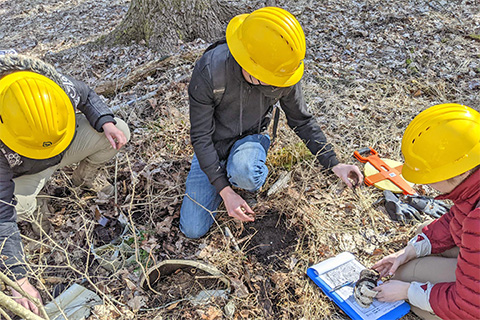The newest addition to DCNR's successful Pennsylvania Outdoor Corps is the Cultural Resources Crew.
The four-person team is an archaeological and architectural history-focused field crew developed to conduct cultural resources management activities throughout the commonwealth's 121 state parks and more than two million-acre state forest system.
Supporting DCNR's Cultural Resources Program

Cultural resources are the remains of past human activity. In Pennsylvania, there's nearly 20,000 years of human history. It's no surprise then that state parks and forests are steeped in both natural and human history.
Not long ago, the department added the position of Cultural Resources Program Coordinator to help document and protect the buildings, artifacts, sites, and landscapes our forebears left behind.
The new Outdoor Corps Cultural Resources Crew provides support to the new program and the state parks and forests by helping to preserve, interpret, and manage the shared public heritage of all people to the benefit of future generations.
In return, the crew's field technicians receive experience, training, and mentoring as aspiring archaeologists and preservationists helping them build successful careers in land and resource management.
Meet the Cultural Resources Crew

The crew consists of a Secretary of Interior-qualified historic preservation professional, archaeologist Katherine Peresolak, M.A., RPA, as the field director, and three crew members: Miriah Amend, Isaiah Cullum, and Haley Rumbel.
All members have bachelor's degrees in history, historic preservation, or archaeology.
Halfway through the year already, the crew has worked through 15 individual projects with plans to complete another eight projects by the end of the year!
Projects like archaeological surveys, metal detector surveys, research investigations, oral history collection, curation of artifacts, and curation of archival documents have kept the crew hopping as they rove across Pennsylvania to various parks and forests.
Training opportunities have included learning advanced metal detecting techniques at Fort Ligonier, attending the South Mountain Science Summit, participating in a blacksmith forging demonstration by the Jamestown Rediscovery blacksmiths, taking chainsaw training, and taking part in a cultural resources management-related seminar series.
Work on Cultural Resources in State Parks and Forests

The Cultural Resources Crew is structured with a three-part focus on research, compliance-related projects, and inventory needs.
Research-oriented investigations in support of agency initiatives and interpretation efforts include supporting programs like DCNR's Untold Stories or strategic planning efforts like Penn's Parks for All.
Compliance-related projects include Phase I (identification) and II (evaluation-level archaeological and historic building surveys.
Many compliance projects are typically those required by the State Historic Preservation Office for cultural resources review.
Inventory efforts often focus on survey, recordation, assessment, and development of long-term maintenance or management plans for valued cultural and historic resources.

Many of the investigations carried out by the Cultural Resources Crew center on the application of non-intrusive methods for identifying and delineating cultural resources including pedestrian reconnaissance, metal-detecting and geophysical surveys, GIS-based mapping, recording, and entry in the Pennsylvania State Historic Preservation Office's PA-SHARE system.
The crew tackles excavation methods including shovel test pits and larger test units. It also helps conduct archaeological site and historic structures assessment for at-risk cultural resources.

With training in the preservation trades, the crew hopes to tackle limited historic preservation maintenance like historic masonry restoration and repair, re-pointing stone, brick and patching and cleaning stone, historic window sash and jamb repairs, shutter repairs, flooring, and porch repairs, and more.
Projects of the Cultural Resources Crew

Aside from being a really amazing example of a circa 1770s log house structure in Fayette County, the Carroll Cabin in Forbes State Forest was the subject of the master's thesis for crew leader Peresolak.
As a graduate student at Indiana University of Pennsylvania, Peresolak's research focused on developing a historic context for, recordation, and exploratory archaeological investigation of the Carroll Cabin and its historic setting.
Participating in its continued preservation and work progressing on the site represents a unique opportunity for her and the crew to see the preservation process play out.
This month, the Outdoor Corps American Sign Language youth crew out of Pittsburgh cleaned the structure out of debris to make way for the next phases of restoration on-site when the Cultural Resources Crew will return.
Upcoming work focused on the Carroll Cabin preservation is sponsored in part by the Pennsylvania Parks and Forests Foundation.
At Penn-Roosevelt and Pymatuning State Parks, the Cultural Resources Crew has started preliminary investigation of two segregated Civilian Conservation Corps camps.

Archaeological methods like pedestrian reconnaissance and surface survey, metal detecting, and more traditional excavation techniques seek to expand on the untold stories of the past.
One of archaeology's greatest strengths is that it goes beyond what was written or said, to what people did and how they really lived.
By digging into the documentary and hidden history of our parks and forests, stepping back to take a hard look with more information about lived experiences, DCNR can provide a nuanced and open-eyed view of our past, for the future.
Keep an eye out this summer and fall and you might see the latest addition to DCNR's Pennsylvania Outdoor Corps, in their natural habitat with shovels or trowels in hand alongside one of your favorite historic buildings!